Jog falls - A dream come true
Since childhood I always wanted to visit Jog falls, which came true only now even after being in Karnataka for decades. As a kid it was one of my dream locations.
It was during the peak monsoon season of August, with mild rains and a wonderful driving experience from Bengaluru to Sagara.
 |
| Jog falls |
Sharavati backwaters:
We started our journey by visiting Sri Sigandur Chowdeshwari Temple; the 45min ride into the forest from Sagara to Holebagilu was simply amazing. Holebagilu (the river gate) is the place where the road ends and backwater starts. The spectacular views of Sharavati backwaters can be seen from here, which is surrounded by Sharavati wildlife sanctuary. The 15min ferry ride from Holebagilu to other side of the backwaters was an incredible experience. Unlike the backwaters in Kerala, Sharavati backwaters are not commercialised, so don't expect any boathouse, hotels or even restaurants around the backwaters. The temple is another 2km away from here, which can be covered by bus or taxi. Last ferry from Sigandur towards Holebagilu is at 5.30pm, so plan accordingly.
Sagara to Jog falls:
The next day morning was most awaited, started from Sagara and took the deviation from NH69 after Talaguppa towards Kargal. The deviation from Kargal road towards Honnemaradu was in pathetic condition, so had to skip it and started towards Linganamakki dam. There is a view point at a hairpin bend on the route where we can see Linganamakki dam at a faraway distance. After a scenic ride we reached Linganamakki dam, only to hear that it is closed to public and allowed only with a permit from the authority. Nevertheless we were still enthusiastic as our most anticipated destination was yet to come.
We had a stopover at the check dam before Kargal while coming from Iduvani, which passes through a bridge crossing the Sharavati River.
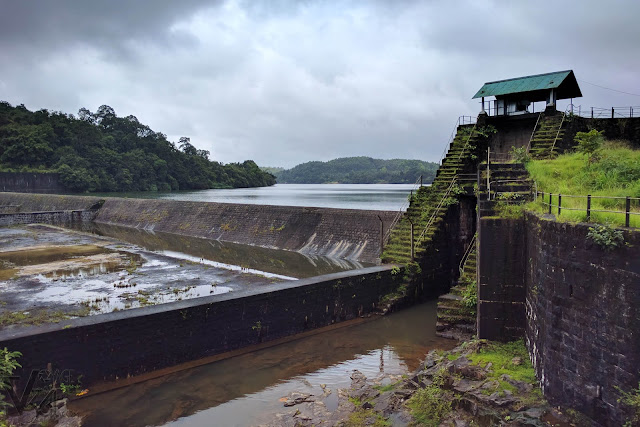 |
| Sharavati river Check dam near Kargal |
 |
| Bridge crossing over the Sharavati river |
 |
| Canal for Krishna Rajendra hydroelectric Power Plant |
Water channelling to Jog falls:
Linganamakki dam is built across the Sharavati River, submerging major part of the forest around the Sharavati wildlife sanctuary. The water from the dam flows to Talakalale Balancing Reservoir through a canal and the remaining water is left to continue as Sharavati River. Later from Talakalale Balancing Reservoir the water flows to irrigation and some amount of water is left for Sharavati Power Generation Plant, which finally joins the Sharavati River.
The water left towards the Sharavati River from Linganamakki dam later gets collected in a small check dam. This check dam splits the river to form another canal which flows to Krishna Rajendra hydroelectric Power Plant (also called as Mahatma Gandhi Hydroelectric Power Plant), so the remaining excess water from the check dam continues through a rocky bed as Sharavati River only to fall from a whopping height of 960 ft split into four parts as Raja, Roarer, Rocket and Rani together called as the Jog falls. With a 253m (830 ft) drop through raja, it makes Jog falls the second-highest plunge waterfall in India.
 |
| Sharavathi river flowing through the rocky bed |
If the falls were not seen as a source of electricity production and if it were a permanently free-flowing waterfall, it would have been one of the most powerful waterfalls on the planet. At its peak it can stretch over 500metre wide. Unfortunately, due to the construction of the dams and hydro power stations, in present days one can see only about 5-10% of its peak strength even during monsoon season.
Hoping that in future the government will recognize that Jog falls is one of the greatest assets of Karnataka, and look for alternative power generation techniques, to give the falls its past glory to some extent.
Jog Falls:
We reached Hotel Mayura Gerusoppa Jogfalls an hour early for our check in, and while the hotel room was getting cleaned we had our first glimpses of the falls from the viewpoints near the hotel.
After check-in to the hotel and having lunch at the Mayura hotel, we started to climb down the steps to reach the base of the jog falls.
1400 steps trek to the base of Jog falls:
There are well paved 1,400 steps to reach the base of the falls. In case you cannot climb down 1,400 steps, one can still get great views at various levels down the stairways.
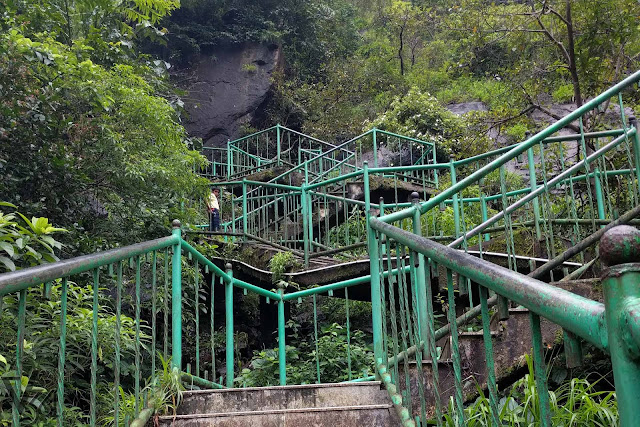 |
| Steps laid-down to the base of the jogfalls |
It took us about 30 mins to reach the base, and our altimeter was showing 217m (MSL). The spectacular views from here cannot be described in words; one should experience it to feel this nature's marvel.
 |
| Spectacular views from the base of Jog falls |
The return journey took us about 40 mins to climb up the 1,400 steps to the top when our altimeter was showing as 470 m (MSL). The distance covered from base to top was about 1 km, while the elevation rise was roughly 253 m.
 |
| Flora on the wet rocks |
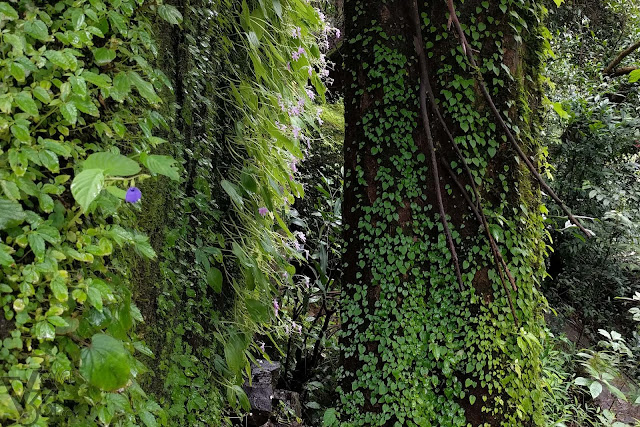 |
| greenery covered on the rocks and trees |
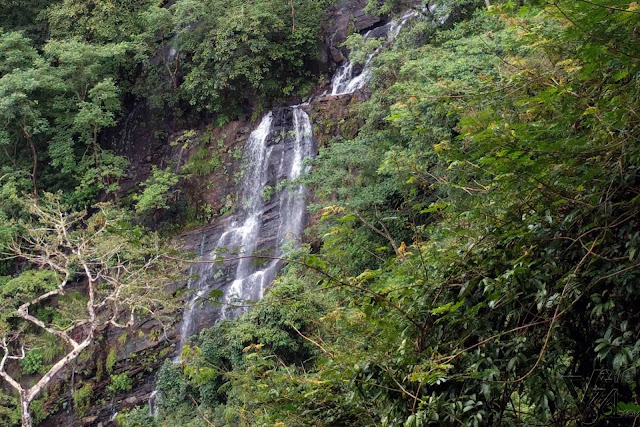 |
| Small waterfalls on the way to the base of jog falls |
 |
| Crab trying to hide inside the rocks |
Jog falls as seen at various levels during the trek:
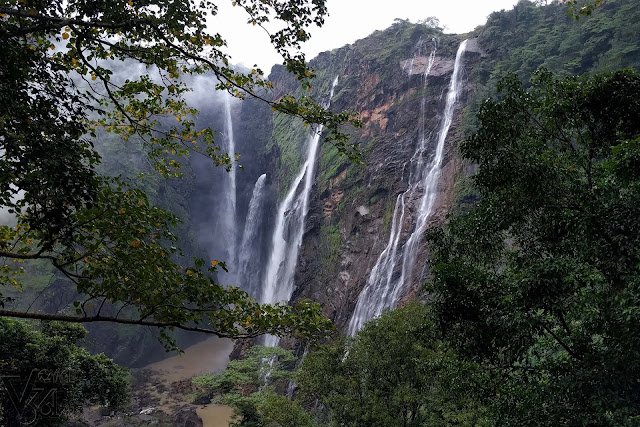 |
| Jog falls as seen from behind the trees |
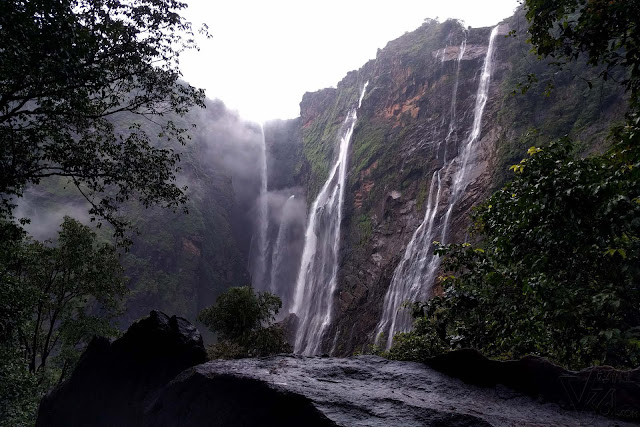 |
| View of the Jog falls through the rocks |
Jog falls view points:
Jog falls can be viewed from several viewpoints, the best is the view point built opposite to the falls, where one can see a panoramic view of the raja, roarer, rocket and rani portions of the jog falls along with Gowrishankara falls, which flows during the monsoon season. The Mayura hotel and restaurant is also located in this place.
 |
| Gowrishankara falls, which also falls from an height similar to Jog falls about 960ft |
Another view point is about 3km away at the British bungalow which is on the Honnavar-Sagar Highway; from here one can view the falls from the closest proximity.
 |
| Jog falls view (roarer, rocket, & rani) from British Bungalow |
 |
| Rocket and Rani |
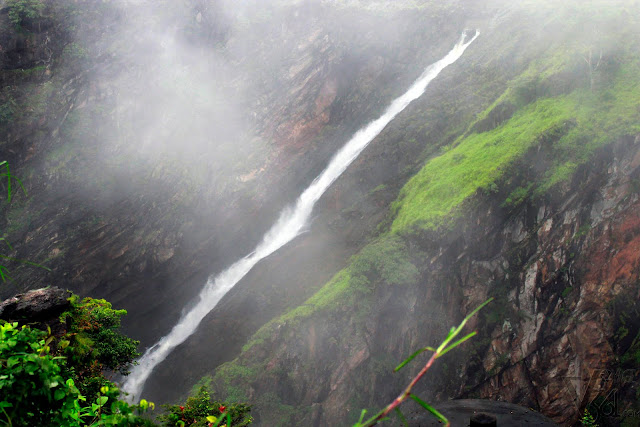 |
| Roarer from British Bungalow view point |
Apart from the waterfalls there’s nothing much to do at the place, as the sun goes down you’ll feel bored hanging around at the Mayura Hotel as there was power shutdown also and hardly any quality food in the restaurant.
The next day morning started feeling the pain in the legs, after the previous day hike to the jog falls base. That could not stop me for a sunrise walk at the jog falls.
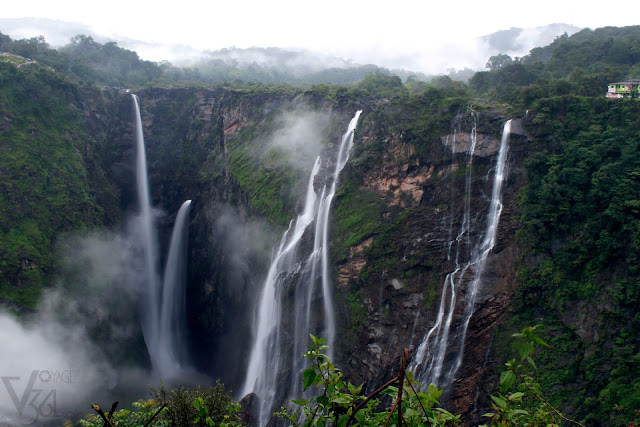 |
| Jog Falls in the morning mist |
Adored the quietness in the absence of crowd and the majestic sound of waterfalls with birds chirping around, it appeared as if it were a painting out of a fairy-tale. The long walk along the viewpoints took me to the Jog valley view point near the hydro-power station. There were many waterfalls around here, the distant gerusoppa falls, other waterfalls playing hide and seek through the trees at a distance from Gowrishankara falls, and with a colored sky I was spell bounded.
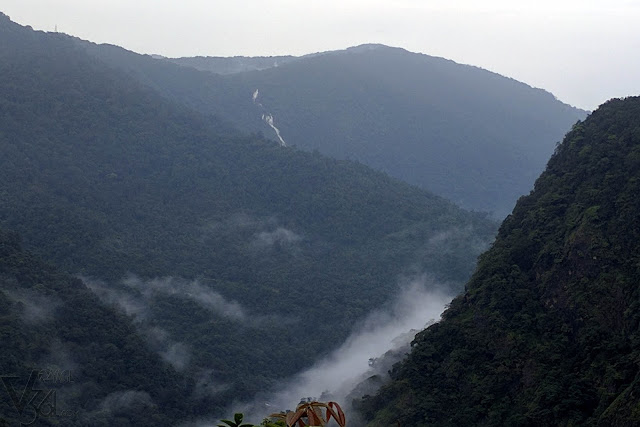 |
| distant gerusoppa falls as seen from the jog valley view point |
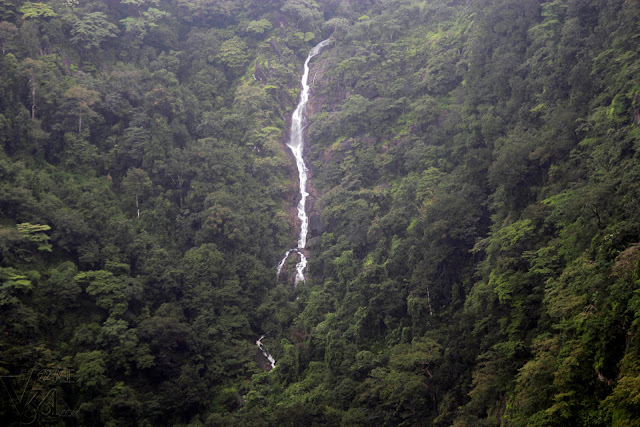 |
| Another waterfalls flowing through the forest canopies |
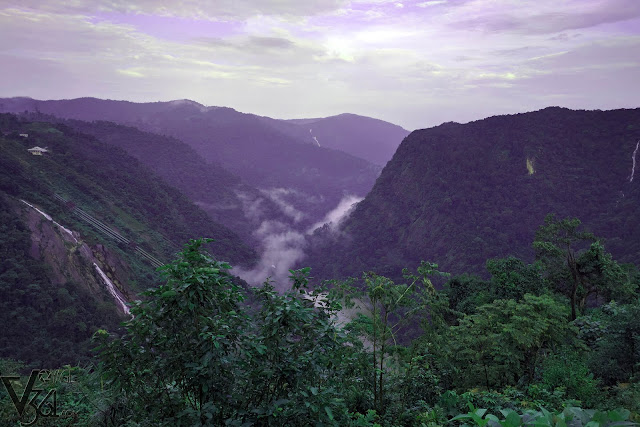 |
| Jog valley view |
It was definitely a dream come true.
Camera Used: Nexus 6P, Canon 550D
Comments
Post a Comment